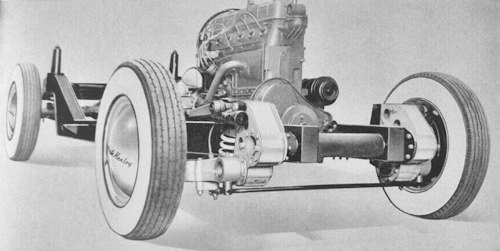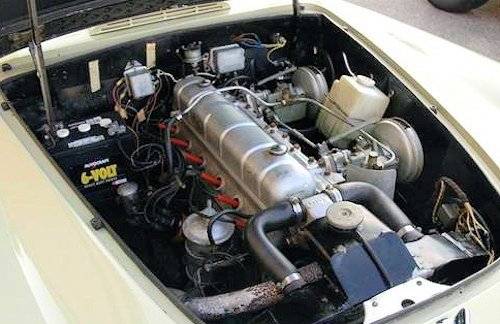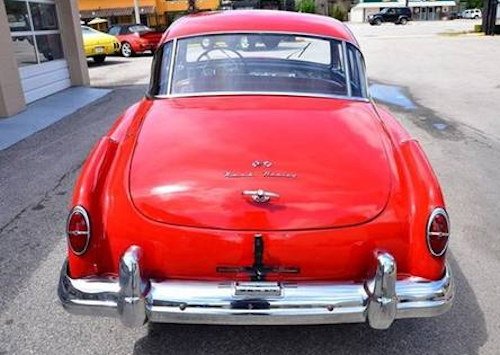Nash Healey history

Nash-Healey was a British - American car brand, which produced from 1951 to 1954 luxury sports cars. The vehicles were from the Donald Healey Motor Company in Warwick, Warwickshire, England, designed and manufactured to the marketing done by Nash Motors.
History
Donald Healey had his automobile factory founded in 1946 and is the leading manufacturer of Gran Turismo, sports cars and racing cars specializes in small numbers and it earned a good reputation. Healey was in long-distance races quite successful and had the Healey Silverstone a competitive racing car in the program.
Company President Donald Healey travelled in 1949 with his son, racing driver Geoffrey Healey, to the United States to promote his cars and look for more powerful engines; So far, he used the larger four-cylinder engines of the manufacturer Riley, as they were used in its RM series (2443 cc). Only for the 3 Litre he resorted to the six-cylinder engine from Alvis, an OHV engine with a capacity of 2993 cc. The power of the two engines 104 bhp or 77.6 kW with Riley engine resp. 106 bhp or 79 kW with Alvis Engine was comparable. By 1949, Cadillac had released a ground-breaking new OHV V8 engine with 5424 cc (330.9 ci) and 160 bhp (117.76 kW).
The very wealthy American racing driver Briggs Cunningham ordered from Healey a custom-made Silverstone with this engine. Due to the impressive performance Donald Healey planned to launch a small series of this car. Therefore, the Healey wanted to use their stay in the United States, to negotiate with Cadillac for the supply of engines. Although they were not averse to the deal, the deal did not materialize because Cadillac's parent General Motors intervened and banned the delivery. The reasons are unclear; a whole range of other companies such as Allard in the UK and Kurtis respectively Muntz (only 1951) in the United States used them.
On the return journey with the passenger ship RMS Queen Mary, the Healey’s met by chance George W. Mason know, the president of the Nash Kelvinator Corporation and thus manufacturer of the Nash -Automobiles. This was ready to provide for Healey engines, manual Borg-Warner three-speed gearbox, cardan shafts and differentials
Upon arrival of the ship, a corresponding contract was signed. Mason also wished to sell the new sports car through its own dealer network, because Nash had no sporting model and no image carrier to offer. Of course, for Healey, selling in the United States became much easier, even though he was not allowed to bring the car out under his own name and had to make concessions in design.

For the first time Healey used a series- six-cylinder engine in Le Mans in 1950; At that time, the chassis of a Healey Silverstone had been modified accordingly. Nash Healey agreed delivery of the Dual Jet fire Six with dual ignition of in Nash Ambassador was offered. The two-valve engine with OHV valve control had a displacement of 3845 cc (234.6 cc); Bore × stroke was 85.70 × 111.10 mm. The engine also had mechanical tappets, a compression ratio of 7.3: 1, a single carburettor a power of 115 bhp @ 3400 / min (86 kW). Healey, however, this engine has been revised: It received a "sharper" camshaft, instead of the cast iron cylinder head, such as an aluminium, with which the compression could be increased to 8: 1, and two SU carburettor instead of the simple single carburettor. This enabled a stable performance increase to 125 HP @ 4000 / min (93 kW). The Nash factory code for the car was 25162. No engine options were offered at the factory. However, some owners took advantage of the generous space and built V8 engines from other manufacturers, such as Cadillac.
The Healey brand had a brief but fairly successful racing career since 1946, the year it was founded. A big hit was the 4th place at the 24 Hours of Le Mans in 1950 for Team Tony Rolt / Duncan Hamilton with a Silverstone Special with the 3.8 litre Nash six-cylinder engine similar to the later production version. In this race, only 29 of all the 66 cars started.
1951 the team reached the same drivers with a new coupe (car no. 19) the class win and 6th place, though it was so late that there is hardly time for training remained. With the front of them Aston Martin, the supplied Nash Healey an exciting circuit duel; in the finish he had come up to eight seconds.
The biggest success was the third final rank of the British Leslie Johnson and Tommy Wisdom at Le Mans in 1952 with a new Barchetta (starting No. 10) behind two Mercedes-Benz 300 SL but ahead of the factory teams of Ferrari, Aston Martin Jaguar, Lancia, Talbot -Lago, Porsche, Osca and others at the same time, they finished second in their class, second in the Rudge-Withworth Biennial Cup for the best performance in two consecutive years and won the Motor Gold Challenge Cup. Donald Healey later said that the car had no technical problems other than a (locally repaired) exhaust and would not have consumed a drop of oil! The fourth placed Cunningham with Chrysler -V8 was on target 80 miles (130 km) back. A second Nash-Healey with the start number. 11 of the French Pierre Veyron and Yves Giraud-Cabantous was considered faster, but did not finish.
In 1953 John Fitch should have taken one of the Nash-Healey, but he moved to Cunningham, so Leslie Johnson and Bert Hadley (GB) formed a team. They drove to 11th place. Veyron / Giraud-Cabantous were once again among the 35 of 60 vehicles that failed to finish. winners of the race were Rolt / Hamilton to Jaguar two former factory driver of Nash-Healey.

The chassis of the Nash-Healey (Type N) is derived from that of the Healey Silverstone (Type E). Like all Healey chassis, it was designed by AC Sammpietro. To provide more comfort, it was designed a little wider and also reinforced for the much heavier engine. It consists of a box frame (18-gauge steel plate) with cross struts. Also typical of Healey, designed by Sammpietro front axle with a swing arm independent suspension, two crank- arms and a cornering stabilizer was used along with the patented steering. This is based on the principle of a rotating plate and a steering linkage, which transmit the forces from the steering gear to the wheels. The rear leaf springs of Silverstone were replaced with coil springs. Depending on the source was a rear axle of Nash resp. Salisbury used. She was led on a Panhard. The vehicle also received hydraulic support from Bendix for the drum brakes, which is important for the US market. The Roadster has a wheelbase of 102 inches (2591 mm), the track front and rear each 1346 mm (53 inches); behind it was widened from 1952 to 1397 mm (55 inches). Steel wheels with plain chrome wheel caps were factory-fitted; the tire size was 6.40 × 15. Later, spoke wheel caps were optional.
Because the Nash-Healey was designed for sale in the United States, the vehicles were built with left-hand drive. There is an indication that a single vehicle may have been steered to the right, but the chassis number indicated G525 indicates a Healey 3 Litre (Alvis-Healey). Nash-Healey use the letter "N" as the first position of the number; Alvis-Healey "G".
First series
The car received a roadster design with formal similarities to the earlier Healey Sports mobile and 3 Litre (Alvis-Healey). The design contributed to Healey designer Benjamin Bowden, supplier of the bodies was the Panel craft Sheet Metal Company in Woodgate, Birmingham, like all Healey factory bodies, these were also made by hand from aluminium. As the only construction of Healey but they lack the typical diamond-shaped radiator grille as Healey mark; Mason insisted on using the radiator grille of a Nash to underline the brand affiliation, after all, the Nash-Healey was indeed intended primarily as an image carrier.
Panel craft completed the bodies in a single series in early 1950, so they only had to be recalled. 30 bodies were additionally produced for the Healey 3 Litre (Alvis-Healey); these differed externally, above all, through another front. Final assembly took place at Healey in Warwick, paying attention to the use of Nash hardware to simplify maintenance. The interior was high quality and included leather trim and an adjustable steering wheel. Overdrive, cigarette lighter and white wall tires completed the basic equipment. The car weighed 1179 kg and was therefore by no means an extraordinary lightweight at that time.
The transport routes resulting from the applied production processes are the main reason for the skyrocketing cost of the sports car: Nash delivered its components to Healey to Warwick, where the chassis was built and the parts of Nash were installed. Complemented to "Rolling Chassis", they were shipped to Birmingham to Panel craft. There they received bodywork and interior equipment and then went back to the mentioned final assembly and final acceptance to Healey. Because most of the Nash-Healey were sold in the United States, the passage across the Atlantic was still ahead of them.
The prototype of the Nash-Healey was shown in 1950 at the car shows in London and Paris, the vehicle production itself began in December 1950. By the end of the year 36 cars were completed. The official presentation took place at the International Auto Show Chicago early 1951. More 68 Nash-Healey came to the end of March 1951. / Altogether 104 copies were built from the first series.
Officially, only the colours Champagne Ivory (Ivory) and Sunset Maroon (Wine Red) were available. Healey might ship the vehicles in Champagne Ivory on the assumption that this colour would be well received in the United States; Having arrived in the United States, Nash painted her on Sunset Maroon. This subsequent change of colour could explain why some specimens have got a lime green colour.
The biggest obstacle to success was the price: a list price of US $ 3767 to US $ 4063 was not competitive.
Second series
Pininfarina in Turin had been commissioned by Nash, in competition with the in-house styling department under Edmund Anderson to make proposals for the lines of the upcoming models; some details like the radiator grille were taken over; the rest came from Nash.
In this environment, Nash Pininfarina asked for a revision of the Nash-Healey Roadster. This received also the order for the production of the body. For this reason, Healey suffered a production stoppage from April 1951 to January 1952 and a late introduction of the 1952 model; During this time, production was set up in Turin. Pininfarina built the car bodies no longer made of aluminium, but steel sheet; only bonnet, trunk lid and doors were made of light metal. The weight increased to 1247 kg. Among the few changes to the chassis belonged to a slightly wider rear track.
Although the car seemed sportier, nevertheless, the new lines were taken somewhat ambiguous. The in-head headlight front was typical of the Nash design and was as controversial and discussed at the Nash-Healey. The hubcaps wore on request imitated spokes. After all, won a 1953 Nash Healey in Italy an international Concours elegance in its class Nash, the vehicle did not call more Roadster, but convertible (Cabriolet), and gave him the plant code 25262.
Pininfarina built from February 1952 until the end of the model year 150 Roadster Series 2 with the 3.8-liter engine to a list price (US $ 5908), of the equivalent of two well-equipped midsize car corresponded, after all, the chassis were now sent to Turin instead of Birmingham and came more or less completely back to final assembly and acceptance to Warwick.
There was little change for the Roadster (factory code 25362) Pininfarina also built a two-seat coupé variant called Le Mans with a panoramic rear window on a slightly longer wheelbase of 2743 mm (108 inches) code 25367. Given the modest sales and the planned 1954 merger with Hudson motor Car Co. for American Motors Corporation, the 1953 model was built longer than usual. as of February, was the latest version of the engine, called Le Mans Dual Jet fire Six with a larger displacement of 4138 cc (252.5 ci) fluently introduced. At the factory, this engine produced 130 bhp (95.7 kW) at 3700 rpm.After the usual treatment by Healey the compression increased from 7.6: 1 to 8: 1 and the power to 140-142 hp (104.5 kW) at 4000 / min.

Due to the poor sales figures, the model year was extended. For this year it is only known that 162 Nash-Healey were built, but not, as many in which of the four versions:
Roadster; 3.8 litres (until February 1953)
Coupe; 3.8 litres (until February 1953)
Roadster; 4.1 litres (from February 1953)
Coupe; 4.1 litres (from February 1953)
1954-1955
On June 3, 1954 and thus already after the merger of Nash with Hudson appeared the "new" Nash-Healey. The Roadster was not offered anymore. The coupe received instead of the one-piece a three-piece rear window and the factory code 25467. All of them had the larger engine with 4.1-liter displacement.
The restriction on the coupe lifted the Nash-Healey also from the 1953 introduced and now in free sales from the Chevrolet Corvette. Although Nash dropped the list price to US $ 5128, it was still not competitive compared to the US $ 3513 Corvette.
At the end of model year 1954, a few Nash-Healey remained unsold. Nash rewrote them to 1955 chassis numbers and described them as new models; a not uncommon practice at this time, which is also known for example by Kaiser. A total of 90 coupes of both "model years" emerged.
After the merger with the AMC, the production of the Nash-Healey was quietly ended. The decision was easy because the largest merger so far of US industrial history brought enough publicity and Donald Healey closed his company anyway in the same year to produce the Austin-Healey with Austin.

